Welcome to our free classical music site

Do you write about classical music? Are you a blogger? Want to team up with Classical Connect? Send us a message, let's talk!

Do you write about classical music? Are you a blogger? Want to team up with Classical Connect? Send us a message, let's talk!
May 21, 2012. Richard Wagner was born on May 22, 1813 in the Brühl, a street in the Jewish quarter of the city of Leipzig – an ironic twist of fate, considering Wagner’s eventual anti-Semitism. Richard’s father died six months after his birth.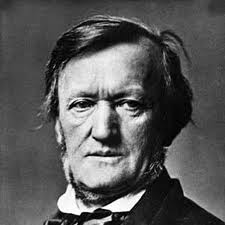 The following year, his mother married the playwright Ludwig Geyer and the family moved to Dresden. In 1821 his step-father died and Richard was sent off to the Kreuz Grammar School in Dresden. At the age of thirteen Richard decided to become a playwright and produced a tragedy, Leubald. Determine to set it to music, Richard persuaded his mother to allow him to receive proper musical instruction. Moving back to Leipzig with his family in 1827, Wagner took his first formal lesson in harmony. There he was introduced to the symphonies of Beethoven, who became a huge influence. In 1831, he entered the University of Leipzig and began composition lessons with the cantor of the St. Thomas Church. He composed a Symphony in C major, his only one and written very much under Beethoven’s influence; the symphony later received performances in both Prague and Leipzig. At the age of 20, Wagner completed his first opera, Die Feen (“The Faires”); it was never staged during his lifetime. He married his first wife, Christine Wilhelmine “Minna” Planer, on November 24, 1836. A year later Wagner and Minna moved to Riga, then a part the Russian Empire, as the music director of a local opera. However, within two years the couple had incurred so much debt that they were forced to flee from their creditors. Their escape led them first to London and soon after to Paris. It was the stormy passage by sea to London that led to Wagner’s inspiration for his opera, The Flying Dutchman. During his four years in Paris (1839-42), Wagner produced Rienzi, his first successful opera, and The Flying Dutchman.
The following year, his mother married the playwright Ludwig Geyer and the family moved to Dresden. In 1821 his step-father died and Richard was sent off to the Kreuz Grammar School in Dresden. At the age of thirteen Richard decided to become a playwright and produced a tragedy, Leubald. Determine to set it to music, Richard persuaded his mother to allow him to receive proper musical instruction. Moving back to Leipzig with his family in 1827, Wagner took his first formal lesson in harmony. There he was introduced to the symphonies of Beethoven, who became a huge influence. In 1831, he entered the University of Leipzig and began composition lessons with the cantor of the St. Thomas Church. He composed a Symphony in C major, his only one and written very much under Beethoven’s influence; the symphony later received performances in both Prague and Leipzig. At the age of 20, Wagner completed his first opera, Die Feen (“The Faires”); it was never staged during his lifetime. He married his first wife, Christine Wilhelmine “Minna” Planer, on November 24, 1836. A year later Wagner and Minna moved to Riga, then a part the Russian Empire, as the music director of a local opera. However, within two years the couple had incurred so much debt that they were forced to flee from their creditors. Their escape led them first to London and soon after to Paris. It was the stormy passage by sea to London that led to Wagner’s inspiration for his opera, The Flying Dutchman. During his four years in Paris (1839-42), Wagner produced Rienzi, his first successful opera, and The Flying Dutchman.
Returning to Dresden in 1842, Wagner was able, through the support of Giacomo Meyerbeer, a noted German Jewish composer, to secure a performance of Rienzi by the Dresden Court Theatre. Further productions included The Flying Dutchman and Tannhäuser. However, his return to Dresden was brief. Wagner became increasingly involved with a socialistic movement that sought to unify Germany and the adoption of a new constitution. When discontent finally reached the breaking point in 1849, the uprising was quickly put down by an alliance of Saxon and Prussian troops. Wagner was forced to flee Dresden for fear of being arrested. The following twelve years were spent in exile in Zurich, Switzerland. During this time he composed Lohengrin and was able to convince his friend, Franz Liszt, to stage the opera in Weimar in August 1850. It was also during this time, that Wagner laid the groundwork for his colossal opera cycle Der Ring des Nibelungen.
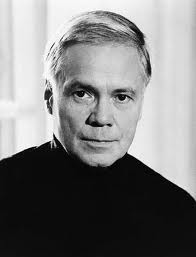 We’ll have many occasions to talk about Wagner’s mature period, but today we’d like to note the passing of one of the greatest singers of the 20th century, Dietrich Fischer-Dieskau, who died on May 18 at the age of 86. Here’s Firscher-Dieskau in an aria from Tannhäuser with the Orchestra of Staatsoper Berlin under the direction of Franz Konwitschny (courtesy of Youtube). This recording was made in the early 1960s. What an incredible voice!
We’ll have many occasions to talk about Wagner’s mature period, but today we’d like to note the passing of one of the greatest singers of the 20th century, Dietrich Fischer-Dieskau, who died on May 18 at the age of 86. Here’s Firscher-Dieskau in an aria from Tannhäuser with the Orchestra of Staatsoper Berlin under the direction of Franz Konwitschny (courtesy of Youtube). This recording was made in the early 1960s. What an incredible voice!
PermalinkMay 14, 2012. Double bass. Usually we don’t think of the double bass as a solo instrument. Surely it provides an indispensable aural foundation to any classical symphony; Johannes Brahms, Gustav Mahler, and Richard Strauss used the instrument extensively in their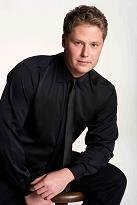 compositions, but as a solo? It seems one would have to go back all the way to Giovanni Bottesini, the “Paganini of the double bass,” to hear music written for the bass as a solo instrument. But don’t tell that to the people of the Bradetich Foundation. The Foundation, established by the distinguished bassist and teacher Jeff Bradetich, was created “with the sole purpose of advancing the performing, teaching and knowledge of the double bass,” as they put it on their web site. The Foundation also runs an International double bass competition, and this, inaugural year, the winner was Artem Chirkov. Listen to his virtuoso interpretation of Astor Piazzola’s Contrabajeando (here) and you’ll agree that the Bradetich Foundation has a point!
compositions, but as a solo? It seems one would have to go back all the way to Giovanni Bottesini, the “Paganini of the double bass,” to hear music written for the bass as a solo instrument. But don’t tell that to the people of the Bradetich Foundation. The Foundation, established by the distinguished bassist and teacher Jeff Bradetich, was created “with the sole purpose of advancing the performing, teaching and knowledge of the double bass,” as they put it on their web site. The Foundation also runs an International double bass competition, and this, inaugural year, the winner was Artem Chirkov. Listen to his virtuoso interpretation of Astor Piazzola’s Contrabajeando (here) and you’ll agree that the Bradetich Foundation has a point!
Artem Chirkov is the principal double bassist of the St. Petersburg Philharmonic orchestra, the youngest in orchestra’s 130-year-old history. Artem began studying cello at the Special Music School of the St. Petersburg Conservatory and at the age of 16, switched to the double bass and continued at the St. Petersburg Conservatory with professors Alexander Shilo and Riza Gimaletdinov. After graduating from the Conservatory, he went on to study at the Hochschule fur Music und Theater in Munich with Professor Klaus Trumpf. In addition to winning the Bradetich Competition, Artem is also the First prize winner at the International competition Virtuosi 2000 in St. Petersburg; the Johann Matthias Sperger International Double Bass competition in Michaelstein, Germany; and International Double Bass competition in Brno, the Czech Republic. He also received the 2nd prize in the International Double Bass competition of the International Society of Bass (Virginia/USA).
Atrem holds Principal Bass positions in numerous ensembles, including the St. Petersburg Camerata under conductor Saulus Sondeckis. He gave numerous master classes: at the Mannes School in New York, at the USC-Los Angeles and Institute of Music San Diego, at the universities of Tokyo and Taipei, and many conservatories in Russia. He performed solo at Pablo Casals festivals in Prades (France) and San Juan, Puerto-Rico, with St. Petersburg Camerata; International Double Bass week Zmok Wojnowice in Poland; with Yehudi Menuhin Society in Munich; at Oleg Kagan Music Festival in Kreuth; the Coburg Music Festival (Germany), Music Festival in Viana do Castelo, Portugal, among other.
We’ll hear several pieces performed by Artem and his wife, the pianist Mavzhida Gimaletdinova. Here is Chant du ménestrel, Op. 71 by Glazunov. The famous Vocalise by Rachmaninov is here. And here is a solo piece by the Czech composer and double bass virtuoso Miloslav Gadjos, Invocation (2002). You can listen to other performance by Artem Chirkov in our library.Permalink
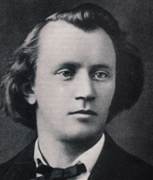 May 7, 2012. Brahms and Tchaikovsky. Two great Romantic composers were born on this day, Johannes Brahms in 1833, in the great Hansean city of Hamburg, and Pyotr Tchaikovsky in 1840, in a provincial city of Votkinsk (we usually follow the awkward tradition of using a patronymic in Tchaikovsky’s name but very much hope that it would be dropped: in Russia every person has a patronymic, but nobody presents Rachmaninov in English as “Sergei Vasilievich” or Mussorgsky as “Modest Petrovich.” If anyone knows the history behind the tradition of calling Tchaikovsky “Pyotr Ilyich,” please let us know).
May 7, 2012. Brahms and Tchaikovsky. Two great Romantic composers were born on this day, Johannes Brahms in 1833, in the great Hansean city of Hamburg, and Pyotr Tchaikovsky in 1840, in a provincial city of Votkinsk (we usually follow the awkward tradition of using a patronymic in Tchaikovsky’s name but very much hope that it would be dropped: in Russia every person has a patronymic, but nobody presents Rachmaninov in English as “Sergei Vasilievich” or Mussorgsky as “Modest Petrovich.” If anyone knows the history behind the tradition of calling Tchaikovsky “Pyotr Ilyich,” please let us know).
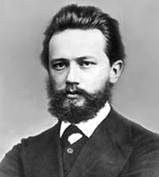 Tchaikovsky was even more of a late bloomer than Brahms. His piano Scherzo op. 1 is dated 1867 when he was 27. Tchaikovsky started his education in a School of Jurisprudence in St. Petersburg, and at that time studied music only sporadically. His regular music lessons started only when he was 15 (his teacher didn’t think much of his musical potential). At the age of 21 Tchaikovsky attended classes on music theory organized by the Russian Music Society. One of the organizers of the Society was Anton Rubinstein, and one year later, in 1862, the classes evolved, with the help of Rubinstein, into the St-Petersburg Conservatory. (Four years later his brother, Nikolai, a good friend of Tchaikovsky’s, would establish the Moscow Conservatory). Pyotr enrolled in the first class of the Conservatory. Even though very little was composed by Tchaikovsky during those years, Anton Rubinstein considered him “a composer of genius.” Still, he didn’t like his First Symphony, written in 1866. That year Tchaikovsky graduated from the St.-Petersburg conservatory and immediately accepted a professorship in the just-created conservatory in Moscow.
Tchaikovsky was even more of a late bloomer than Brahms. His piano Scherzo op. 1 is dated 1867 when he was 27. Tchaikovsky started his education in a School of Jurisprudence in St. Petersburg, and at that time studied music only sporadically. His regular music lessons started only when he was 15 (his teacher didn’t think much of his musical potential). At the age of 21 Tchaikovsky attended classes on music theory organized by the Russian Music Society. One of the organizers of the Society was Anton Rubinstein, and one year later, in 1862, the classes evolved, with the help of Rubinstein, into the St-Petersburg Conservatory. (Four years later his brother, Nikolai, a good friend of Tchaikovsky’s, would establish the Moscow Conservatory). Pyotr enrolled in the first class of the Conservatory. Even though very little was composed by Tchaikovsky during those years, Anton Rubinstein considered him “a composer of genius.” Still, he didn’t like his First Symphony, written in 1866. That year Tchaikovsky graduated from the St.-Petersburg conservatory and immediately accepted a professorship in the just-created conservatory in Moscow.
Considering Brahms’ talent and prodigious output, his first surviving compositions were written rather late: Opus 1, Piano Sonata no. 1 dates from 1853, when Brahms was already 20 (you can listen to it in the performance by Jean-François Latour). (It’s interesting that by the age of 20, Mozart had already written at least 20 symphonies, eight piano concertos, five violin concertos, more than a dozen of violin sonatas, quartets too many to count, and several operas). But we don’t really know the whole story: Brahms was an obsessive perfectionist and apparently destroyed a large number of his early compositions (he claimed to have destroyed 20 early quartets before eventually publishing one in 1773). This is not the only example: the young Brahms worked on a symphony for a number of years, only to turn it into a piano concerto, his No. 1 (1859) – and a good thing too: it’s one of the greatest concertos in all of piano literature. He also worked on his “official” First symphony for fifteen years, from about 1861 to 1876. When he was 20, Brahms’ friend the violinist Joseph Joachim introduced him to Robert and Clara Schumann. Robert was very impressed by Brahms and wrote an article praising the young composer. Eventually Schumann and Brahms co-wrote (with Albert Dietrich) the “F-A-E” violin sonata and dedicated it to Joachim. Brahms was passionately attracted to Clara Schumann. After Robert’s attempted suicide he immersed himself into the family, serving as a go-between Clara and Robert. When Schumann died in an asylum in 1856, Brahms moved into the same house as Clara into an apartment above hers. We don’t know if they were lovers, but Brahms never married, (though he was engaged once), and they destroyed their correspondence. Here is Brahms’s Piano Concerto no. 1. It’s performed by Eteri Andjaparidze with the Russian State Symphony Orchestra under the direction of Valery Gergiev.
Tchaikovsky wrote his Piano Concerto no. 1 in 1874-75. He dedicated it to his friend Nikolai Rubinstein, expecting him to give the first performance. Unfortunately Nikolai didn’t like the concerto. The piqued Tchaikovsky withdrew the dedication and approached the pianist Hans von Bülow who was happy to oblige. The concerto premiered in Boston in October of 1875 with Bülow at the piano and Benjamin Johnson Lang on the podium. The public loved it, and a month later the concerto premiered in New York to great acclaim. We’ll hear it performed by James Dick, with the Texas Festival Orchestra, Robert Spano conducting (here).
PermalinkApril 30, 2012. The word “Wanderer” is close to our hearts these days. It connotes so many states and emotions: nostalgia, wistful retrospection, but also the optimistic sense of beginnings, of new possibilities. Franz Schubert, who didn’t travel much in his life, used the word Wanderer in the title of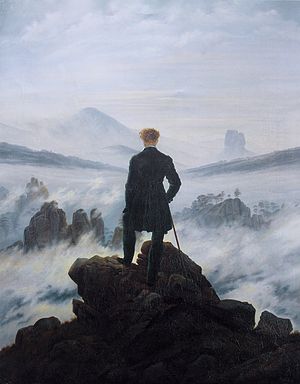 several very different pieces, and each time to denote a state of mind, not the body. In 1816, when he was just 19 but already entering his mature compositional period, he wrote a Lied Der Wanderer (D. 493) on the text by Georg Philipp Schmidt, a minor German poet. In the song, the protagonist, a "stranger everywhere," is searching for “his land,” his friends, a place he could call his own. This beautiful Lied is sung here by the incomparable German baritone Dietrich Fischer-Dieskau, with Gerald Moore on the piano (courtesy of YouTube).
several very different pieces, and each time to denote a state of mind, not the body. In 1816, when he was just 19 but already entering his mature compositional period, he wrote a Lied Der Wanderer (D. 493) on the text by Georg Philipp Schmidt, a minor German poet. In the song, the protagonist, a "stranger everywhere," is searching for “his land,” his friends, a place he could call his own. This beautiful Lied is sung here by the incomparable German baritone Dietrich Fischer-Dieskau, with Gerald Moore on the piano (courtesy of YouTube).
Six years later Schubert wrote a piano Fantasy, so technically demanding that he himself couldn’t play it at all. Schubert used the theme from Der Wanderer in the second movement of the Fantasy, the Adagio (Theme and Variations). That led it to be called Wanderer. You can listen to it here in performance by the Israeli-American pianist Alon Goldstein.
In 1826, only two years before his death and the year preceding the composition of the great Winterreise song cycle, Schubert wrote a Lied to the text of Johann Gabriel Seidl’s poem Der Wanderer an den Mond ("The Wanderer Speaks to the Moon"). It has a simple, almost folk-like tune, with the accompaniment imitating the chords of a guitar. "Happy is he, who wherever he goes, stands on his native soil" is the concluding line of the poem. This little gem (the songs is just a bit longer than two minutes) is sung by the baritone Thomas Meglioranza. Reiko Uchida is on the piano (here).
The illustration, Wanderer above the Sea of Fog, is by the German Romantic painter Caspar David Friedrich. It was made in 1818, just two years after Schubert wrote his first Wanderer.
April 30, 2012. The word “Wanderer” is close to our hearts these days. It connotes so many states and emotions: nostalgia, wistful retrospection, but also the optimistic sense of beginnings, of new possibilities. Franz Schubert, who didn’t travel much in his life, used the word Wanderer in the title of several very different pieces, and each time to denote a state of mind, not the body. In 1816, when he was just 19 but already entering his mature compositional period, he wrote a Lied Der Wanderer (D. 493) on the text by Georg Philipp Schmidt, a minor German poet. In the song, the protagonist, a "stranger everywhere," is searching for “his land,” his friends, a place he could call his own. This beautiful Lied is sung here by the incomparable German baritone Dietrich Fischer-Dieskau, with Gerald Moore on the piano (courtesy of YouTube).
several very different pieces, and each time to denote a state of mind, not the body. In 1816, when he was just 19 but already entering his mature compositional period, he wrote a Lied Der Wanderer (D. 493) on the text by Georg Philipp Schmidt, a minor German poet. In the song, the protagonist, a "stranger everywhere," is searching for “his land,” his friends, a place he could call his own. This beautiful Lied is sung here by the incomparable German baritone Dietrich Fischer-Dieskau, with Gerald Moore on the piano (courtesy of YouTube).
Six years later Schubert wrote a piano Fantasy, so technically demanding that he himself couldn’t play it at all. Schubert used the theme from Der Wanderer in the second movement of the Fantasy, the Adagio (Theme and Variations). That led it to be called Wanderer. You can listen to it here in performance by the Israeli-American pianist Alon Goldstein.
In 1826, only two years before his death and the year preceding the composition of the great Winterreise song cycle, Schubert wrote a Lied to the text of Johann Gabriel Seidl’s poem Der Wanderer an den Mond ("The Wanderer Speaks to the Moon"). It has a simple, almost folk-like tune, with the accompaniment imitating the chords of a guitar. "Happy is he, who wherever he goes, stands on his native soil" is the concluding line of the poem. This little gem (the songs is just a bit longer than two minutes) is sung by the baritone Thomas Meglioranza. Reiko Uchida is on the piano (here).
The illustration, Wanderer above the Sea of Fog, is by the German Romantic painter Caspar David Friedrich. It was made in 1818, just two years after Schubert wrote his first Wanderer.
PermalinkApril 23, 2012. Sergei Prokofiev was born on this day in 1891. He belonged to a "post-Tchaikovsky" generation of Russian greats, together with the somewhat older Rachmaninov, who was born in 1873, and Stravinsky, born in 1882. All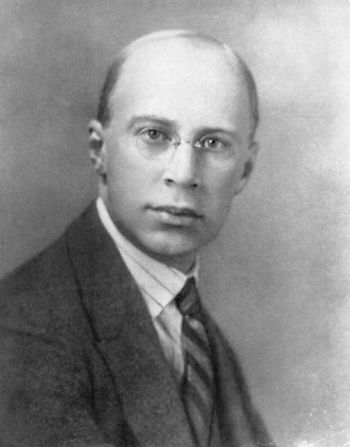 three became accomplished composers before the Revolution of 1917 and all three left Russia after it happened. But unlike Rachmaninov and Stravinsky, both of whom were quite anti-Soviet in their views, Prokofiev, after almost 20 years living in Europe, decided to return to the Soviet Union. It was never clear why he made this decision. He knew about the lack of artistic and political freedoms in the Soviet Union, and he had heard of the purges. Still, he returned. Part of the reason, it seems, was that his career in the West didn’t develop as well as he expected. Ambitious, brilliant, talented, he expected to become a great success when he first moved to the US. As successful as he was, however, the American public clearly preferred another émigré from Russia, the more conservative Rachmaninov. On a number of occasions, Prokofiev was overheard saying, "There is no room for me here while Rachmaninov is alive, and he will live another ten or fifteen years."
three became accomplished composers before the Revolution of 1917 and all three left Russia after it happened. But unlike Rachmaninov and Stravinsky, both of whom were quite anti-Soviet in their views, Prokofiev, after almost 20 years living in Europe, decided to return to the Soviet Union. It was never clear why he made this decision. He knew about the lack of artistic and political freedoms in the Soviet Union, and he had heard of the purges. Still, he returned. Part of the reason, it seems, was that his career in the West didn’t develop as well as he expected. Ambitious, brilliant, talented, he expected to become a great success when he first moved to the US. As successful as he was, however, the American public clearly preferred another émigré from Russia, the more conservative Rachmaninov. On a number of occasions, Prokofiev was overheard saying, "There is no room for me here while Rachmaninov is alive, and he will live another ten or fifteen years."
In 1920 he moved to Paris, but there he found himself competing with Stravinsky. For a Russian composer in Paris, the patronage of Sergei Dyagilev was very important. In the 1920s, Prokofiev wrote several ballets, but only The Prodigal Son became really successful. Stravinsky, on the other hand, already famous for his Petrushka and The Rite of Spring, had several hits with Pulcinella, the new version of Les noces, Apollo, and The Fairy’s Kiss. Still, if one considers Prokofiev’s output from 1918 through 1936, this period was extremely productive: he wrote several operas, among them The Love for Three Oranges and the updated version of The Gambler, three symphonies, Romeo and Juliet (ballet and the orchestral suite), the Third, Forth and Fifth piano concertos and also concertos for violin and cello, and many other works. Never quite a part of the Russian émigré community, sometime in the mid-20s Prokofiev began developing contacts with the Soviet musicians. For propaganda reasons, the Soviets were very keen on having him return. In 1927 Prokofiev accepted an invitation to tour the Soviet Union. His opera The Love for Three Orange was staged in the Mariinsky Theater; Mayakovsky and Meyerhold were also wooing him back. In1932 he started spending half of his time in Moscow, and by 1936 he had settled there permanently. As a person famous in Europe and America, he expected immunity from the oppressive Soviet state, and at the beginning it seemed to work that way: he was given a large apartment, a car with a driver, and was promised the unheard of privilege of unrestricted travel to the West. Unfortunately, these freedoms didn’t last. Almost immediately, the musical censors went to work, criticizing some of his music as not sufficiently "Social Realist," and by 1948 he, as well as Shostakovich and some other composers, were officially denounced as “formalists”; his works, written during the emigration, were banned and he lived his remaining years in virtual seclusion. He died on March 5, 1953, the same day as Stalin.Permalink
April 16, 2012. Two Trios by Schubert. In Schubert’s time the piano trio was a very popular form: home music making was common, and many pieces, originally written for the orchestra, were often arranged to be played on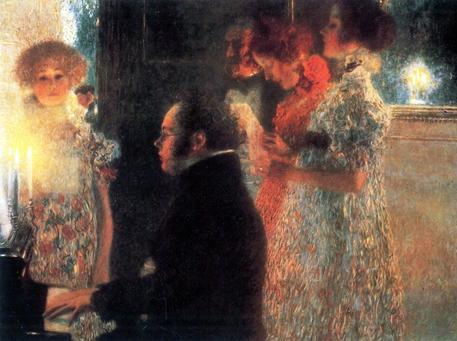 three instruments: the violin, cello, and piano. And of course by then a large volume of music was already written specifically for the trio. Haydn, the pioneer, wrote 45 of them, Mozart wrote six, Beethoven, in addition to arranging two of his symphonies, also wrote several trios, including the famous "Archduke." Schubert composed two of his trios at the very end of his short life. He started both of them in 1827, the year when, in an immense burst of creativity, he wrote several masterpieces, including the song cycle Winterreise, the last three piano sonatas, the Mass in E-flat Major, and the String Quartet D. 956. It is thought that the first trio, the one in B Major, was finished in 1828, the year of Schubert’s death; it wasn’t published till 1836. The listener might not guess that this bright, lively and utterly charming piece, about which Robert Schumann said, “One glance at Schubert's Trio and the troubles of our human existence disappear and all the world is fresh and bright again," was written almost at the same time as the tragic Winterreise, and by a severely ill composer. The trio is in a classical four-movement form (Allegro, Andante, Scherzo, Rondo); it is performed here by the Tecchler Trio (Benjamin Engeli, piano, Esther Hoppe, violin, and Maximilian Hornung, cello).
three instruments: the violin, cello, and piano. And of course by then a large volume of music was already written specifically for the trio. Haydn, the pioneer, wrote 45 of them, Mozart wrote six, Beethoven, in addition to arranging two of his symphonies, also wrote several trios, including the famous "Archduke." Schubert composed two of his trios at the very end of his short life. He started both of them in 1827, the year when, in an immense burst of creativity, he wrote several masterpieces, including the song cycle Winterreise, the last three piano sonatas, the Mass in E-flat Major, and the String Quartet D. 956. It is thought that the first trio, the one in B Major, was finished in 1828, the year of Schubert’s death; it wasn’t published till 1836. The listener might not guess that this bright, lively and utterly charming piece, about which Robert Schumann said, “One glance at Schubert's Trio and the troubles of our human existence disappear and all the world is fresh and bright again," was written almost at the same time as the tragic Winterreise, and by a severely ill composer. The trio is in a classical four-movement form (Allegro, Andante, Scherzo, Rondo); it is performed here by the Tecchler Trio (Benjamin Engeli, piano, Esther Hoppe, violin, and Maximilian Hornung, cello).
The second trio, in E-flat Major, D.929, was written in November of 1827, just weeks after the first one. Schubert heard very few performances of his last compositions, but this one he did, as it was played in January of 1828 at a private party for his good friend, Josef von Spaun. Very different in tenor than the sunny B-flat Major trio, it is much more dramatic and moody. Stanley Kubrick, the movie director, brilliantly used the second movement of the trio, Andante con moto to create an unsettling, anxious atmosphere of his film Barry Lyndon. The complete trio is performed here by Bella Hristova, violin, Dane Johansen, cello, and Adam Golka, piano.
(Illustration: Schubert at the piano, Gustav Klimt, 1899. At that time Klimt was havinig a love affair with the young Anna Schindler who was soon to become Anna Mahler) Permalink